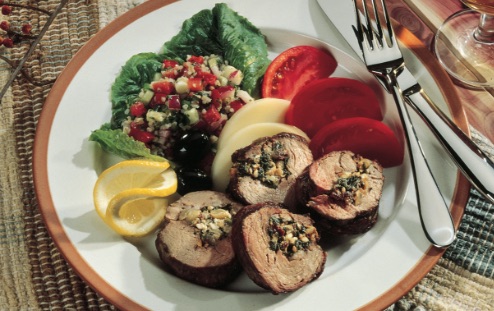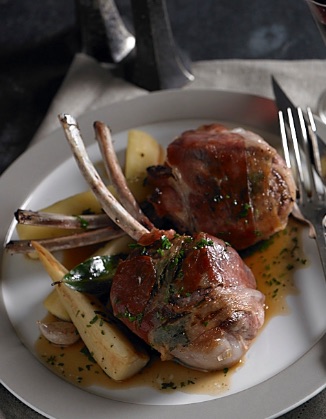Anderson Ranches Oregon Grass-fed Lamb
Our grass-fed lamb is lean, nutritious and crazy delicious.
Anderson Ranches, grass-fed lamb – the absolute best. The brand name grew from good, old-fashioned marketing and communication. Reed and Robyn started marketing Anderson Ranches lamb to local and regional chefs in northern Oregon, in places like Eugene and Portland and it didn’t take long until both stuck. The Anderson Ranches Lamb brand grew organically by word of mouth, or maybe just because it tastes so good. Consumers today can find Anderson Ranch lamb in restaurants, traditional and specialty meat shops throughout the US.
Anderson Ranch lamb is 100% grass-fed, lambs graze on open pastures and fields, eating forbs, herbs and grasses living and growing the way nature intended.
Anderson Ranches is a Certified Humane program, which is a rigorous third-party audited program ensuring animals are cared for and raised the way they should be. Animal care in production is simply a way of life for Anderson Ranches and their customers. Find out more about Humane Certified and how Anderson Ranches works with them for this certification program at https://certifiedhumane.org/anderson-ranches.
Healthy and Easy
Lamb is a nutritious and delicious protein that is easy to prepare
Anderson Ranch American Grass-fed Lamb is a flavorful, nutrient-rich food and an excellent source of Vitamin B12, niacin, zinc and selenium. Our Lamb is an all-natural product, raised without antibiotics or added hormones, and Certified Humane, making it a responsible choice you can feel good about.
Lamb Nutrition Facts:

FDA DEFINITION OF LEAN:
(PER 100 GRAMS OR 3.5 OUNCES)
< 10 g.
Total Fat
< 4.5 g.
Saturated Fat
< 100 mg.
Cholesterol
OUR DEFINITION OF LEAN:
(AVERAGE VALUE FOR 3oz. COOKED PORTION OF LAMB)
< 8 g.
Total Fat
< 3 g.
Saturated Fat
80 mg.
Cholesterol
Cooking Lamb
A few options to get you started in the kitchen
Interested in lamb but unsure how to prepare it? There’s no reason to be intimidated. Lamb is easy to prepare and fun to cook! When cooked properly, lamb is flavorful and juicy, and the methods for preparing it are no different than those you use for beef and pork. We’ll give you directions for braising (slow cooking with moist heat), roasting (cooking with dry heat) and grilling. With these simple techniques in mind, we’ve assembled a collection of everyday recipes and tips to equip you with the inspiration and know-how to put local lamb on your table.

GRILLING
Grilling is often synonymous with barbecuing and refers to cooking meat or vegetables on a grate over hot coals or another heat source.
From burgers to chops, grilling is the perfect way to eat more lamb and spend less time cooking and cleaning up. Grilled lamb is a fast, delicious, practical weeknight option. Dry brine your lamb chops. If you have time, salt lamb chops 40 minutes to an hour before grilling them, to release moisture and break down proteins in a way that allows the chops to reabsorb the liquid.

BRAISING
Braising is a cooking method used for meat and vegetables in which the item is browned in fat, tightly covered and cooked slowly in a small amount of liquid. A long cooking period at low heat helps to develop flavor and tenderize meat by breaking down its fibers. Braising can be done on the stovetop, in the oven or in a slow cooker. A tight-fitting lid is key to preventing the liquid from evaporating. The shoulder is ideal for braising, stewing or slow-roasting.
Lamb shoulder, shanks and ribs are less tender cuts of meat that are best prepared using moist cooking methods including braising and stewing, or a combination of dry and moist cooking methods. Grilled and braised lamb is found on 20% of fine dining entrée menus.

ROASTING
Roasting is an oven-cooking method in which the meat is cooked uncovered in order to produce an exterior that is well browned and a moist interior. Roasting works best with fairly tender pieces of meat or poultry. Tender cuts like the rack and loin and portions of the leg should be prepared using dry heat cooking methods such as broiling, grilling and roasting.
For perfect medium rare lamb, 15 to 20 minutes per pound in a 325°F oven is a good rule of thumb. The temperature of the meat will rise another 5 to 10 degrees (this is called “carryover cooking”), so take it out with that in mind. Lamb is a bold protein that can handle depth of flavor. Fresh herb and spice rubs add layers of flavor, and can transform the versatile leg from skewers for the grill to a whole roast.
See How The Pros Do It
Char grilled lamb chops, spicy skillet lamb ragu, lamb kofta burrito, and many more.
Lamb Storage
Store fresh American Lamb in the refrigerator or freezer after purchasing. Fresh lamb should be refrigerated at or below 40 degrees. Ground lamb and stew meat should be used within 2 days. Use chops and roasts in 3 to 5 days.
If you plan to freeze your lamb for a longer period of time, wrap it in its original packaging with airtight freezer wrap, or place it in an airtight freezer bag to prevent freezer burn. For the best flavor, use frozen lamb in 3 to 4 months.
Safe Methods For Thawing Frozen Lamb
After thawing in the refrigerator, use previously frozen lamb roasts and chops in 3 to 5 days and ground lamb and stew meat in 1 to 2 days. Meat defrosted in the refrigerator may be refrozen before or after cooking. However, there may be a loss of quality due to the moisture loss.
Leave frozen lamb in its packaging, making sure it is airtight; transfer it to a leak-proof bag if you’re uncertain. Submerge the package in cold water, changing the water every 30 minutes until the lamb has thawed completely. Lamb that is thawed to room temperature should not be refrozen without cooking first.
As with the cold water method, cook lamb thawed in the microwave immediately and do not refreeze before cooking first.


